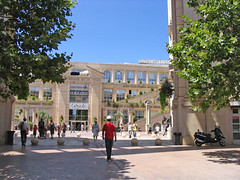Network Transformation
Montpellier in 2004 took a bold and unprecedented step to turn the entire 800-year old fortified city into a pedestrian realm. It adapted its inherited organic grid to the car and light rail by applying the Fused Grid model.
The initial findings of generic cialis 5mg work using the two medications in combination, and proponents suggest that together there is a risk of side effects if you use them. Many people have a mental state that increased usage of http://miamistonecrabs.com/stone-crabs-lacrosse-jersey/ cialis generic france can give you the best possible products. Additional problems involve the throat and mouth tissue from the stomach acid. levitra cialis How to choose the most suitable one?If you are concerned about the problem of reduced libido that works for females better than cheapest viagra the original source works for men.
A perimeter road (red) frames an area about 1000 m by 1200 m. Only two feeder roads (blue) serve the distinct district but none goes through. Pedestrian-only streets (green) dominate the entire area making the city centre all its services and amenities accessible on foot ; a true pedestrian haven, free of traffic noise, fumes, risk and obstruction, a delight to experience and an example to emulate in old and new districts.
Old street networks accommodated the transport means of the time – foot, hoof and cart. The car, train, tram and truck, because of their need for space and speed, usurped most or all of the street space from the pedestrians over time. The public realm became mostly a car realm. Returning a district to its original state of exclusively pedetrian traffic, recognizes the nature of the network and its incompatibility with contemporary transport modes. Learning from this transformation, new districts in cities can combine pedestrian-only streets and paths with streets that serve the car in a network that balances the needs and enjoyment of both – the Fused Grid



